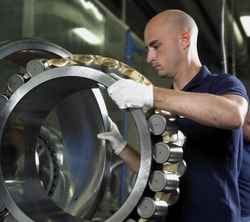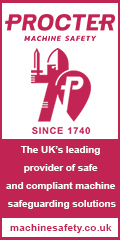
Posted to News on 14th Aug 2013, 18:26
Cutting costs with remanufactured bearings
In many sectors of industry, it is now common practice to remanufacture rolling bearings as they age in order to extend their operating life. This is especially true of larger bearings used in heavy machinery, including steel and paper mills, and in power generation and renewable energy. Phil Burge, Communication Manager for SKF explains how modern remanufacturing techniques extend bearing life and support sustainability.

Before a bearing can be considered suitable for remanufacture it first has to be carefully checked using techniques such as ultrasonics to detect micro-fissures and other wear in raceways, rings and rollers that might be invisible to the naked eye. If remanufacturing is deemed appropriate then the bearing can be dismantled, ground, polished and repacked.
Not all bearings are suitable for remanufacture, and neither is this process always the most economical choice, but there are many occasions when this sometimes overlooked alternative represents a cost-effective route that extends bearing life, reduces maintenance costs and supports sustainability.
Bearing remanufacture - sometimes called bearing repair or bearing refurbishment - has become a trusted tool because it involves going far beyond a visual inspection of a dismounted bearing to examine the condition of the steel under the surface. A bearing may have raceways that appear undamaged to the naked eye, but the presence of micro cracks in the subsurface indicates that the bearing is near its end of life. Under normal operating conditions, a bearing has to withstand the maximum shear stress below the surface. If it is sufficiently loaded, the material structure will change and micro cracks will appear. Historically, engineers have either risked repeated use of worn bearings without really knowing what is going on underneath the surface, or discarded bearings that could have been reconditioned because even grinding the raceway surface and changing the rollers cannot allay concerns over the subsurface condition of the steel. This is why today's remanufacturing processes incorporate additional processes such as ultrasonics, which can detect subsurface micro cracks and thus establish whether a bearing can be successfully remanufactured.
Better machine availability
Cost-benefit analysis has shown that remanufacturing can exact a saving of as much as 80 per cent against the cost of a new bearing. And there are further advantages; for example, a major benefit of remanufacture is that it enables engineering firms to sidestep the potentially costly delays to production that can be incurred when orders for replacement bearings are subject to long lead times. Remanufacture also allows facilities to maintain better machine availability and stock reduction, while the damage analysis data gathered during the remanufacturing process can identify recurring areas of high maintenance and failure that can then be addressed as part of an ongoing preventative maintenance programme.
The objective is not to remanufacture a bearing so that it is equivalent to a brand new one; it is to increase the service life of the bearing. Service life is generally limited by raceway damage due to incorrect lubrication, contamination, or markings that result from poor handling or storage. On a paper machine, for example, bearings often do not reach their potential service life as a result of contamination. A dent created by an over-rolled hard particle will disturb the load distribution along the roller/raceway contact surface, causing stress to be locally increased, which accelerates fatigue. However, if a bearing is judged to be suitable for remanufacture, which in some applications will require an ultrasonic examination as described earlier, then the service life is increased by removing such surface damage.
Remanufacturing centres offer several service levels and optional processes depending on the bearing involved, the type of damage and, most importantly, the application. When a bearing arrives at an SKF remanufacturing centre, it is visually inspected before parameters such as residual magnetism and clearance are checked. This gives an initial impression about the state of the bearing and establishes whether it is suitable for remanufacture. After this, the bearing is disassembled and thoroughly cleaned before the components are inspected and their dimensions measured.
Measurements such as ring wall thickness and ovality are always taken, while those such as ultrasonic testing, hardness, roller diameter set variation and outer dimensions are added depending upon the application. This initial assessment phase is then concluded by the submission of a report and a recommendation for treatment. Recommendation for reworking is categorised into classes, from Class I - Reclassification, which typically includes reconditioning operations such as buffing, polishing, grinding of scratches and grooves, and demagnetisation, through to Class IV, with each stage adding further levels of component replacement and refurbishment to the remanufacturing process.
Today, bearing manufacturers can deliver bearing remanufacturing services with excellent results. Based on more than 100 years of knowledge and experience with rotating machinery, SKF has developed detailed and application-specific processes that maximise the potential of bearing remanufacture. They employ the same high-quality materials, methods and machinery to rework bearings as those that are used in the original manufacture. With such services available, the option to remanufacture and restore the original quality specifications of rolling bearings presents a significant opportunity to increase efficiency. And in terms of sustainability, the argument in favour of remanufacturing is as robust as the refurbished bearings themselves; SKF estimates that the remanufacturing of 100kg of used bearings leads to a reduction of about 350kg in CO2 emissions.
For further information about bearing remanufacturing services from SKF, please visit www.skf.co.uk.
Want the latest machine building news straight to your inbox? Become a MachineBuilding member for free today >>

















